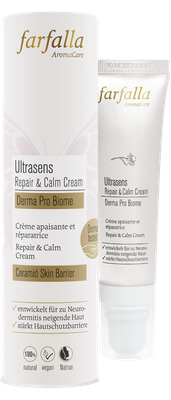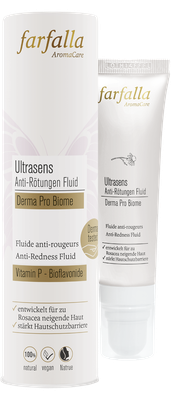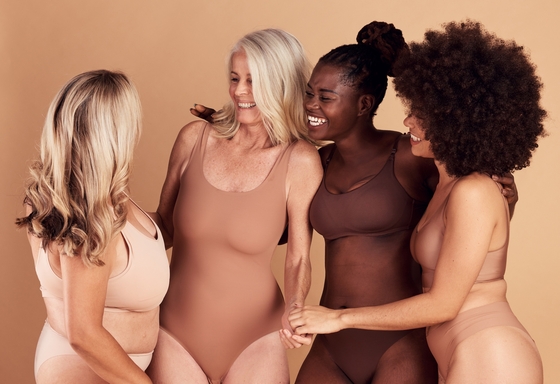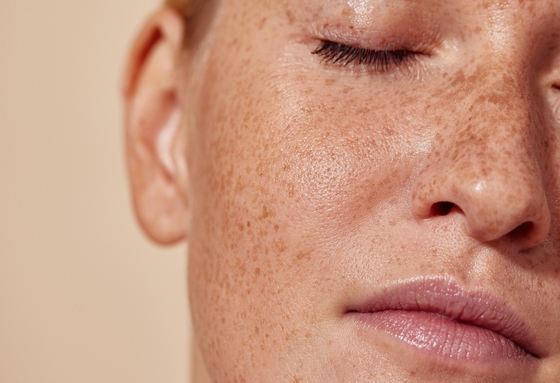Rosacea
Does your rosacea present you with major challenges in life and skincare? The right skincare routine and an optimised lifestyle can make a big difference when it comes to dealing with rosacea or couperose.
Rosacea is a chronic inflammatory skin disease that affects the small blood vessels. It occurs in episodes and is visible in the centre of the face on the nose, chin and cheeks. It occurs when the skin no longer fulfils its protective function properly, becomes permeable and dries out: the immune system then no longer functions properly and inflammation occurs. The inflammation causes the blood vessels to dilate, which manifests itself in the reddening of the skin surface. Rosacea is a multifactorial disease. It mainly affects hypersensitive and vasoreactive skin, i.e. skin whose blood vessels dilate very easily. In all cases, there is a congenital weakness of the connective tissue. Rosacea mostly affects middle-aged women with light-coloured skin. It can be confused with acne or other skin diseases. Rosacea can be triggered by various factors such as internal triggers (emotions, hormones) and external triggers (environmental pollution, wind, sun, nicotine or the excessive presence of the Demodex mite). Typical symptoms include feelings of heat and tightness, redness and visible blood vessels on the face. A holistic approach that combines the right skin care with a healthy lifestyle can improve the quality of life with rosacea.
Couperose is caused by a weakness of the connective tissue, which is associated with dry skin. The skin is thin, with fine pores and often sensitive with scaly patches. The dilated vessels extend in a butterfly shape from the cheeks over the nose. The causes of couperose can be a congenital weakness of the connective tissue, disorders of the autonomic nervous system, excessive sun exposure, lack of protection against the cold, incorrect skin care, excessive intake of stimulants such as coffee, nicotine, alcohol or high blood pressure.
Couperose is often regarded as a precursor or early stage of rosacea. In many cases, however, couperose and rosacea can occur independently of each other. A visit to a dermatologist for an accurate diagnosis and a suitable treatment strategy is essential in both cases.
The right care for rosacea and couperose
Gentle cleansing is key
Use a mild cleanser or almond oil to gently cleanse your skin. Avoid overly aggressive cleansing products so as not to put additional strain on the skin barrier.
Soothing care products
To minimise discomfort, natural and particularly mild care products that support the microbiome and thus the skin's immune system are called for. Prebiotic ingredients replenish the skin's natural flora, thereby suppressing harmful microorganisms. Rutin, a natural bio-flavonoid, can help to protect the skin and reduce redness with its antioxidant and anti-inflammatory properties. The skin-soothing aromatherapy stars such as almond oil and chamomile floral water score highly with their soothing properties. They help to moisturise the skin and strengthen the natural protective barrier.
Look after your skin carefully and try different products to find the best results for you. A personalised skincare routine that includes organic plant waters and organic skincare oils alongside a cream can help to improve your skin health.
Conceal redness
Making visible redness disappear will already significantly improve the way your skin feels. The Derma Pro Biome Anti-Redness Fluid reduces redness and soothes irritated skin immediately. Bioflavonoids reduce capillary permeability and increase the skin's microcirculation. Developed for rosacea-prone skin, also suitable for couperose-prone skin.
Don't forget
Always remember good cold protection to protect the blood vessels from extreme conditions.
Of course, also protect your skin from UV rays, as these can aggravate both rosacea and couperose.
Soothing aromatherapy for couperose and rosacea
Other ways to make your skin happy
You are unique - every person with rosacea reacts differently to potential triggers. Keep a diary of your diet, activities and environmental factors to identify and avoid your triggers.
Regular gentle vascular training
Get into the habit of taking measures to improve the resistance of your blood vessels and reduce redness and the visibility of dilated blood vessels (telangiectasias). For example, you can alternate hot-cold-warm-cold rinsing twice a day when you cleanse your face.
Drink a lot - but preferably no alcohol
Sufficient water intake is very important for the skin, especially for rosacea and other sensitive skin issues. Drink enough water to moisturise your skin and flush toxins from the body. Well-hydrated skin is better protected from irritation.
A healthy diet
A healthy diet is not only good for your body, but also for your skin. Avoid hot spices, as these can trigger rosacea flare-ups, as can alcoholic substances. Instead, focus on a balanced, wholesome diet with plenty of vegetables, fruit and lean vegetable protein. Above all, keep a close eye on what can trigger a flare-up for you personally.
The benefits of fitness
Regular physical activity promotes blood circulation and improves the supply of oxygen, which can have a positive effect on the skin. To avoid stress, overheating and skin irritation, not all types of sport are necessarily equally suitable. Find out what suits you and is the best for you.
Stress management
Unfortunately, stress is also a known trigger for rosacea flare-ups. Stress management techniques such as yoga, meditation or breathing exercises, in combination with the right essential oils, can support your emotional balance. A relaxed lifestyle will have a positive effect on your skin.
Good sleep
Restful sleep is essential for the regeneration of your skin. Try to get enough sleep and prioritise a regular sleep-wake cycle. This not only supports your skin, but also your general well-being








